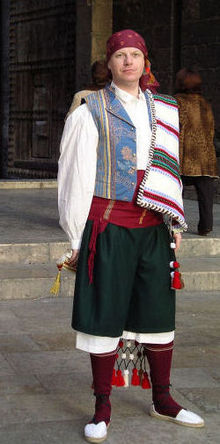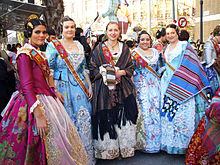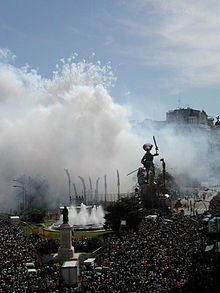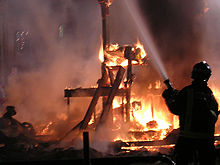- Falles
-
The Falles (Valencian: [ˈfaʎes], sing. Falla; Spanish: Fallas) is a Valencian traditional celebration in praise of Saint Joseph in Valencia, Spain. The term Falles refers to both the celebration and the monuments created during the celebration. A number of towns in the Valencian Community have similar celebrations inspired in the original one from the city of Valencia.
Each neighbourhood of the city has an organized group of people, the Casal faller, that works all year long holding fundraising parties and dinners, usually featuring the famous specialty paella. Each casal faller produces a construction known as a falla which is eventually burnt. A casal faller is also known as a comissió fallera.
The name of the festival is thus the plural of the Valencian word falla. The word's derivation is as follows:
- Latin fax "torch" → Latin facvla (diminutive) → Vulgar Latin *facla → Valencian falla.
Contents
Falles and ninots
Formerly, much time would also be spent at the Casal Faller preparing the ninots (Valencian for puppets or dolls). During the week leading up to March 19, each group takes its ninot out for a grand parade, and then mounts it, each on its own elaborate firecracker-filled cardboard and paper-mâché artistic monument in a street of the given neighbourhood. This whole assembly is a falla.
The ninots and their falles are developed according to an agreed upon theme that was, and continues to be a satirical jab at anything or anyone unlucky enough to draw the attention of the critical eyes of the fallers — the celebrants themselves. In modern times, the whole two week long festival has spawned a huge local industry, to the point that an entire suburban area has been designated the City of Falles — Ciutat fallera. Here, crews of artists and artisans, sculptors, painters, and many others all spend months producing elaborate constructions, richly absurd paper and wax, wood and styrofoam tableaux towering up to five stories, composed of fanciful figures in outrageous poses arranged in gravity-defying architecture, each produced at the direction of the many individual neighbourhood Casals faller who vie with each to attract the best artists, and then to create the most outrageous monument to their target. There are more than 500 different falles in Valencia, including those of other towns in the Valencian Community.
During Falles, many people from their casal faller dress in the regional and Valencia costumes from different eras of Valencia's history — the dolçaina and tabalet (a kind of Valencian drum) are frequently heard, as most of the different casals fallers have their own traditional bands.
Although the Falles are a very traditional event and many participants dress in medieval clothing, the ninots for 2005 included such modern characters as Shrek and George W. Bush.
Events During Falles
The days and nights in Valencia are one running party during the five days of Falles. There are processions galore — historical processions, religious processions, and hysterical processions. The restaurants spill out to the streets. Explosions can be heard all day long and sporadically through the night. Foreigners may be surprised to see everyone from small children to elderly gentlemen throwing fireworks and bangers in the streets, which are littered with pyrotechnical debris.
La Despertà
Each day of Falles begins at 5am with La Despertà ("the wake-up call"). Brass bands will appear from the casals and begin to march down every road playing lively music. Close behind them are the fallers throwing large firecrackers in the street as they go.
Mascletà in Valencia
La Mascletà
The Mascletà, an explosive display of the concussive effects of coordinated firecracker and fireworks barrages, takes place in each neighbourhood at 2 pm every day of the festival; the main event is the municipal Mascleta in the Plaça de l'Ajuntament where the pyrotechnicians compete for the honor of providing the final Mascleta of the fiestas (on March 19). At 2pm the clock chimes and the Fallera Mayor (dressed in her fallera finery) will call from the balcony of the City Hall, Senyor pirotècnic, pot començar la mascletà! ("Mr. Pyrotechnic, you may commence the Mascletà!"), and the Mascletà begins.
Mascletà is almost unique to the Valencian Community, hugely popular with the Valencian people and found in very few other places in the world. Smaller neighbourhoods often hold their own mascletà for saint's days, weddings and other celebrations.
La Plantà
The day of the 15th all of the falles infantils are to be finished being constructed and later that night all of the falles majors (major Falles) are to be completed. If not, they face disqualification.
L'Ofrena floral
Each falla casal takes an offering of flowers to the virgin. This occurs all day on their days of March 17 and March 18. The virgin's body is then constructed with these flowers.
Els Castells and La Nit del Foc
On the nights of the 15, 16, 17, and 18th there are firework displays in the old riverbed in Valencia. Each night is progressively grander and the last is called La Nit del Foc, the night of fire.
La Cremà
On the final night of Falles, around midnight on March 19, these falles are burnt as huge bonfires. This is known as the cremà, i.e. "the burning", and this is of course the climax of the whole event, and the reason why the constructions are called falles ("torches"). Traditionally, the falla in the Plaça de l'Ajuntament is burned last.
Many neighbourhoods have a falla infantil (a children's falla, smaller and without satirical themes), which is a few metres away from the main one. This is burnt first, at 10pm. The main neighbourhood falles are burnt closer to midnight. The awesome falles in the city centre often take longer. For example, in 2005, the fire brigade delayed the burning of the Egyptian funeral falla in Carrer del Convent de Jerusalem until 1.30am, when they were sure they had all safety concerns covered.
Each falla is adorned with fireworks which are lit first. The construction itself is lit either after or during these fireworks. Falles burn quite quickly, and the heat given off is felt by all around. The heat from the larger ones often drives the crowd back a couple of metres, even though they are already behind barriers that the fire brigade has set several metres away from the construction. In narrower streets, the heat scorches the surrounding buildings, and the firemen douse the façades, window blinds, street signs, etc. with their hoses in order to stop them catching fire or melting, from the beginning of the cremà until it cools down after several minutes.
Away from the falles, there are people going crazy through the streets, with the city resembling an open-air nightclub, except that instead of music there is the occasionally deafening sound of people throwing fireworks and bangers around randomly. There are stalls selling products such as the typical fried snacks porres, xurros and bunyols, as well as roast chestnuts or various trinkets.
History
There are a few different theories regarding the origin of the Falles festival. One theory suggests that the Falles started in the Middle Ages, when artisans put out their broken artifacts and pieces of wood that they sorted during the winter then burnt them to celebrate the spring equinox. Valencian carpenters used planks of wood to hang their candles on. These planks were known as parots. During the winter, these were needed to provide light for the carpenters to work by. With the coming of the Spring, they were no longer necessary, so they were burned. With time, and the intervention of the Church, the date of the burning of these parots was made to coincide with the celebration of the festival of Saint Joseph, the patron saint of the carpenters.
This tradition continued to change. The parot was given clothing so that it looked like a person. Features identifiable with some well-known person from the neighbourhood were added as well. To collect these materials, children went from house to house asking for Una estoreta velleta (An old rug) to add to the parot. This became a popular song that the children sang to gather all sorts of old flammable furniture and utensils to burn in the bonfire with the parot. These parots were the first ninots. With time, people of the neighbourhoods organized the process of the creation of the Falles and monuments including various figures were born.
Until the beginning of the twentieth century, the Falles were tall boxes with three or four wax dolls dressed in cloth clothing. This changed when the creators began to use cardboard. The creation of the Falle continues to evolve in modern day, when largest monuments are made of polystyrene and soft cork easily molded with hot saws. These techniques have allowed Falles to be created in excess of 30 meters.
Secció Especial
The Secció Especial is a group of the largest and most prestigious falles commissions in the city of Valencia. In 2007, the group consisted of 14 commissions. This class of falles was first started in 1942 and originally included the falles of Barques, Reina-Pau and Plaça del Mercat. Currently, none of these are still in the group. The commission that has most often participated in this group as of 2007 was Na Jordana, with 54 times. Winning the first prize in the Sección Especial is the most prestiguous prize any falla can win. All other falles fall into different classes that also award prizes with the exception of the one erected by the town hall.
See also
List of Winners of Sección Especial of Falles
Falles gallery
- Year 2005
- Year 2008
- Year 2010
External links
- Official page for the Falles of Valencia, Spain
- Official page for the Falles of Valencia, Spain: http://www.fallasfromvalencia.com
- Falles 2007 (in Spanish, Valencian, English, French and German): http://fallas.comunitatvalenciana.com
- Official history of Falles in English
- Gandia Les Falles Information in English
- Explanation of Falles acts in Spanish
- iPhone/iPod applcation about Las Fallas
Cultural domain of Valencian Community History Prehistoric Iberia Treasure of Villena · Iberians (Contestani, Edetani and Ilercavones) Lady of Elx · Roman Hispania Lucentum · Visigothic Kingdom · Al-Andalus · Crown of Aragon (Kingdom of Valencia) · Spanish Empire · Spanish transition · Autonomous communityLanguages Sports Cuisine Musical instruments
and typical musicTraditions and feasts Ball de diables · Bonfires of Saint John · Cavalcade of Magi · Correfoc · Falles · Holy Week · Misteri d'Elx · Muixeranga · Moros i cristians · Tomatina · Bou embolatMusic festivals Category  Spain topics
Spain topicsHistory Prehistoric Iberia · Roman Hispania · Medieval Spain · Union · Expansion · Enlightenment · Reaction and revolution · First Spanish Republic · Restoration · Second Spanish Republic · Civil War · Spain under Franco · Transition to democracy · Modern SpainGeography Autonomous communities · Autonomous cities · Sovereign territories · Provinces · Comarcas · Municipalities · Islands · Extreme points · National Parks · Forests · ClimateGovernance Constitution · Monarch · Government · General Courts · Human rights · Foreign relations · Military · LGBT rightsPolitics Economy Society Culture Architecture · Art · Languages · Literature · Cuisine · Tapas · Wines · Music · Bullfighting · Cinema · Myths and legends · Public holidays · International Fiestas · National Fiestas · Toro de Osborne · Nationalisms and regionalisms · SportPortal Categories:- Valencian culture
- Fire
Wikimedia Foundation. 2010.






















